Yellowtail Blue Damsel (Chrysiptera parasema)
Quick Stats:
- Care Level: Easy
- Temperament: Aggressive
- Diet: Omnivore
- Reef Safe: No
- Minimum Tank Size: 20 gallons
- Max Size: 3 inches
- Water Parameters:
- Temperature: 72-78°F
- pH: 8.1-8.4
- Salinity: 1.020-1.025
- Ammonia, Nitrite, Nitrate: 0 ppm
A Comprehensive Guide to the Yellowtail Blue Damsel (Chrysiptera parasema)
The Yellowtail Blue Damsel, scientifically known as Chrysiptera parasema, is a popular saltwater aquarium fish due to its vibrant colors and hardy nature. In this guide, we will explore various aspects of this species to help you provide the best care in your saltwater aquarium.
Habitat
The Yellowtail Blue Damsel is native to the Indo-Pacific region, including the Great Barrier Reef, Fiji, and the Solomon Islands. It is commonly found in shallow reef areas with plenty of hiding spots among corals and rocks.
Reef Compatibility
The Yellowtail Blue Damsel is generally not considered reef safe. While it may not harm corals directly, it can become territorial and aggressive towards other tank inhabitants, potentially causing stress to corals and other delicate invertebrates.
Size
As an adult, the Yellowtail Blue Damsel can reach a maximum size of around 3 inches. It is a relatively small fish suitable for medium to large-sized aquariums.
Temperament
The Yellowtail Blue Damsel is known for its aggressive behavior, especially towards other similarly-sized or smaller fish. It may establish dominance in the tank and may nip at fins or harass weaker tankmates. Providing ample hiding spots and territories can help mitigate aggression.
Sexual Dimorphism
Sexual dimorphism is not prominent in the Yellowtail Blue Damsel. Males and females look similar, with both showcasing the distinctive blue body and a yellow tail.
Lifespan
The average lifespan of the Yellowtail Blue Damsel is around 5-7 years when kept in proper aquarium conditions. Good water quality, appropriate diet, and a stress-free environment contribute to the longevity of this species.
Diet in Aquariums
The Yellowtail Blue Damsel is an omnivorous fish that will readily accept a variety of foods. In captivity, it can be fed a diet consisting of high-quality marine pellets, flakes, frozen foods like brine shrimp and mysis shrimp, and occasional live foods for enrichment.
Aquascaping Recommendations
When setting up the aquarium for the Yellowtail Blue Damsel, it is important to include plenty of live rock or coral structures to provide hiding spots and territories. This will help reduce aggression and provide a sense of security for the fish. Creating a diverse and natural-looking environment will also enhance the overall aesthetics of the tank.
Captive Bred Availability
As an abundant and popular species in the aquarium trade, the Yellowtail Blue Damsel is often readily available as captive-bred specimens. Captive-bred individuals tend to be hardier and better suited to aquarium life than wild-caught counterparts.
Compatibility with Other Fish, Invertebrates, or Corals
When choosing tankmates for the Yellowtail Blue Damsel, it is crucial to consider its aggressive nature. Selecting fish that are larger, more robust, or have the ability to defend themselves is recommended. Suitable tankmates include:
- Clownfish: Clownfish are generally compatible with Yellowtail Blue Damsels due to their similar size and social structure.
- Firefish: Firefish are peaceful and can coexist with the Yellowtail Blue Damsel as they occupy different areas of the tank.
- Royal Gramma: Royal Grammas are relatively peaceful and can withstand the occasional aggressive behavior of the damsel.
- Pseudochromis: Certain Pseudochromis species, like the Orchid Dottyback, can hold their ground against the Yellowtail Blue Damsel.
- Gobies: Gobies are generally peaceful and can cohabitate with the Yellowtail Blue Damsel without issues.
Other Common Names
The Yellowtail Blue Damsel may also be known by other common names such as Lemon Damselfish or Yellowtail Demoiselle.
Why Buy from Reefs4Less.com
When considering purchasing fish or other marine life, Reefs4Less.com offers several advantages. They provide high-quality specimens that are carefully sourced, ensuring the health and well-being of the fish. Their extensive selection, knowledgeable staff, and commitment to customer satisfaction make them a reliable choice for saltwater aquarium enthusiasts.
Popular Questions about the Yellowtail Blue Damsel (Chrysiptera parasema)
1. Can the Yellowtail Blue Damsel be kept in a reef tank?
While the Yellowtail Blue Damsel is not considered reef safe due to its potential aggression towards other tank inhabitants, it can be kept in a reef tank with caution. Providing ample hiding spots, introducing it as one of the last inhabitants, and carefully selecting compatible tankmates can increase the chances of a successful reef setup.
2. What is the recommended tank size for the Yellowtail Blue Damsel?
A minimum tank size of 20 gallons is suitable for a single Yellowtail Blue Damsel. However, larger tanks with more swimming space and hiding spots are always preferable.
3. Can the Yellowtail Blue Damsel be kept in a community tank?
The Yellowtail Blue Damsel can be challenging to keep in a community tank due to its aggressive nature. It is best to select tankmates that can handle or avoid its aggressive behavior.
4. What is the average price range for the Yellowtail Blue Damsel?
The price of the Yellowtail Blue Damsel can vary depending on factors such as size, captive-bred status, and availability. On average, they can range from $10 to $20.
5. Are there any specific water parameters that the Yellowtail Blue Damsel requires?
The Yellowtail Blue Damsel prefers a water temperature range of 72-78°F, a pH of 8.1-8.4, and a salinity level of 1.020-1.025. Keeping ammonia, nitrite, and nitrate levels at 0 ppm is crucial for their well-being.
| Size | 1 – 2 inches |
|---|

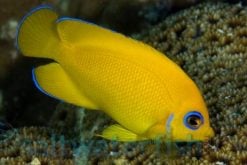 Lemonpeel Angelfish - Central Pacific, Size 2 - 3 inches
Lemonpeel Angelfish - Central Pacific, Size 2 - 3 inches 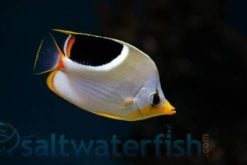 Saddleback Butterfly - Fiji - MAC Certified, Size 2.25 - 3.5 inches
Saddleback Butterfly - Fiji - MAC Certified, Size 2.25 - 3.5 inches 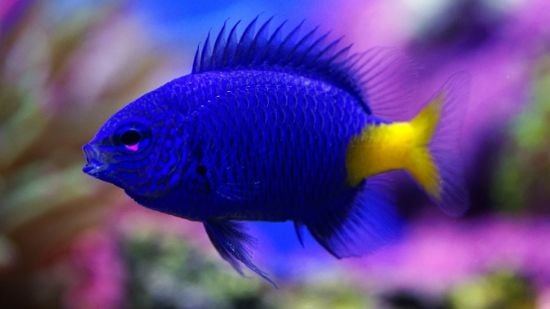
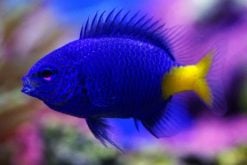
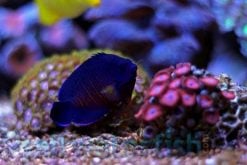
Reviews
There are no reviews yet.